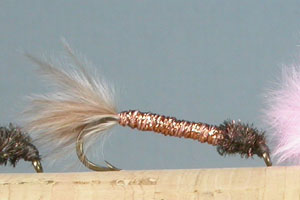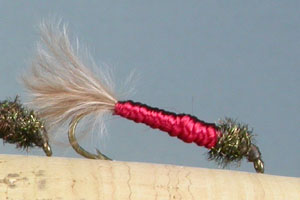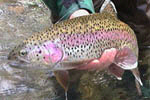My
wife and I had dashed up to northern Vermont for a nice, long,
romantic weekend at a country inn on the banks of the Lamoille
River—and a bit of fly fishing, too, of course. To make a long story
short, the Golden Maple Inn was all it was cracked up to be, but the
fishing was uncharacteristically tough for the Lamoille. (Perhaps it
was the plunging barometer. We were quite literally flooded out on
what should have been our last day—kicked out of the inn before
breakfast, road closures, washouts, the whole nine yards.)
Late in our second day of
fishing, I was standing in mid river behind the inn, staring into my
fly boxes, wondering what to try next. I had noticed some empty bits
of crayfish carapace along the bottom, but foolishly had no crayfish
patterns or Woolly Buggers in my vest. And I was too lazy to slog
back to the car in the gathering gloom. Then I noticed a homely
little nameless thing with a pheasant tail body and pink
hackle-fluff tail.
I wonder if that might suggest a baby crayfish? What the
heck, I figured, nothing else is working.
So I tied it on, cast directly
across the stream and let it drift down. Nothing. I lifted it into a
back cast, placed it across the current again and let it drift
downstream. This time, at the end of the drift, I let it swing as I
swept the rod tip slowly back and forth. Then I twitched on the line
a few times. Instead of lifting the line smartly from the water, I
made a long, slow pull with my line hand to slow-start my back cast.
Bang! Twelve-inch rainbow.
A couple casts later, I lost that
unnamed fly to a snag, so I tied on the nearest thing to it: a
coppery-bodied version with a tan tail. Same result: another
rainbow, about the same size. Hey, I thought. I think I
may be onto something here. Then it started pouring.
Let me explain how those two
little flies came about. A few days earlier, as is my wont, I ended
a session at the vise by messing around with some scraps on the
bench. I had already mounted a 3XL hook, size 10, in the vise, and
had tied on with brown 6/0 thread. Next, I tied in a gap-length tail
of pink hackle fluff that was blowing around. I must have been tying
Pheasant Tail or Teeny Nymphs, because I found myself wrapping a
body of fibers from a cock pheasant tail. I didn’t bother with the
Teeny Nymph’s legs. I added a thorax or head of bronze peacock herl
clippings that were lying on the table. The result looked like the
start of some unfinished fly.
I put another hook in the vise
and started off the same, this time using tan hackle fluff for the
tail. Tired of wrapping pheasant tail fibers (pinching the darn
things is tough on fingers beginning to suffer from osteoarthritis),
I picked up a bobbin holder loaded with Coats & Clark copper
metallic thread and wrapped a body with that. This is fairly thin
thread, so I had to wrap up and back several times to produce a
fairly thin body. I had an appointment to keep, so I "finished" with
the same bronze peacock herl head. Days later, when I was grabbing
some flies I had tied for the Lamoille trip—flies that had been
hanging to dry by the vise—I unthinkingly grabbed the two nameless
little things and popped them into the nymph
box.
When I got back home from that
weekend trip, I started tying more of those little devils, which now
had a name: Near-Nothing Mud Bugs. ("Mud bug" is slang in certain
parts of the country for crayfish, especially baby crayfish.) Now,
when I use the copper thread for the body, I sometimes wrap a thin
underbody of tan or brown yarn, so it doesn’t take as many layers of
thread to give the fly a little "beef."

An odd thing about these Mud
Bugs: So far, they haven’t caught anything but rainbow trout.
Admittedly, I haven’t made a real effort to prove this point.
Closest I have come to an experiment was one day on a certain river
I’d just as soon keep to myself, thank you. The fishing was pretty
decent on a certain stretch, particularly in one deep pool that had
a pretty good current sweeping one side and a tributary entering on
the other. I stationed myself just below the tributary’s inflow,
where I could reach all parts of the pool. Because of the pool’s
depths and the mixing of the currents, the trout were not easily
spooked. For the same reasons, as well as the dense forest canopy,
they couldn’t easily see me, either. Easy, close-in
fishing.
I was able to catch and release
fish in that pool for a good 30 to 45 minutes before the fish
stopped cooperating. During that time, I fished a Near-Nothing Mud
Bug, on which I caught nothing but rainbow trout, and three other
mostly brownish nymphs and streamers, on which I caught nothing but
brown trout. Hardly scientific, but interesting. Elsewhere, I have
had similar experiences with ’bows and brookies.
I don’t know what it is about
this pattern, but, in these hands, Near-Nothing Mud Bugs take nearly
nothing but rainbows.
A little background
music
The Near-Nothing Mud Bugs didn’t
come out of nowhere. In effect, they were refinements of an earlier
pattern. I can’t recall when I first started tying the earlier fly,
but I do know what inspired it. I had long been fascinated by
chironomid (midge) pupal patterns, but I don’t much care for tying
or fishing tiny nymphs. For one thing, I’m not a big fan of strike
indicators. For another, I’m all thumbs at the vise. Then I noticed
that British midge pupal patterns, usually called Buzzers, aren’t
all that tiny—often tied on curved, short-shank hooks as large as
size 12 or even 10. Finally, one day, while perusing Taff Price’s
Fly Tying—An International Guide to Over 400 Fly Patterns, I
saw the Bloodworm—a midge nymph even I could tie well.
The Bloodworm is tied on a size
12 or 14 long-shank hook and has a large, Bugger-like, red marabou
tail, a red floss body "with distinct undulations" ribbed with
fluorescent-red floss, and a bronze peacock herl head.
Over time, the Bloodworm devolved
into an even simpler pattern, which I decided to call the Bloody
Buzzer. The tail became much smaller—just a wisp of hackle fluff or
blood feather, and usually tan or pink rather than red. I kept the
red body, but use two variations. When I use red floss, I use red
metallic thread for the rib, if I use a rib at all. Sometimes, I
just use the red metallic thread for the body. (I’ve tried red tying
thread for the body, but it doesn’t work as well for me.) For the
head, I usually use green rather than bronze peacock herl. I
sometimes use hooks as short as 1XL or as long as 4XL, but 2XL and
3XL are my usual choices. Although I tie the Bloody Buzzer as small
as size 16, I find that size 10 will usually suffice for everything
from bluegills to bass, including trout.

I fish the Bloody Buzzer every
which way: up and across, on the swing, dead drift, twitched,
stripped fast, crawled along the bottom, and everything in between.
About the only way I don’t fish it is below a floating strike
indicator. As I said, I don’t much care for fly-rod bobber
fishing.
To date, the Bloody Buzzer has
caught pretty much everything I have cast it to: rainbows, brookies,
browns, tiger trout; small- and largemouth bass; bluegills,
pumpkinseeds, and other sunfish; fallfish; baby jacks, snappers, and
other saltwater panfish. Everything except yellow perch. (One spring
day at the mouth of a creek on Silvermine Lake in New York’s
Harriman State Park, I tried my darnedest to get perch to take a
Bloody Buzzer, but they simply would not. I came back a few days
later with "Bloodless" Buzzers tied with yellow and light-olive
bodies and the perch could be coaxed into taking them, but not as
avidly as they would take several other flies in my panfish
box.)
So there you have it, two really
simple, effective, and essentially similar fly patterns. One of them
will apparently take nothing but rainbow trout, while the other will
take almost anything but yellow perch. I just love fishing’s
mysteries!



